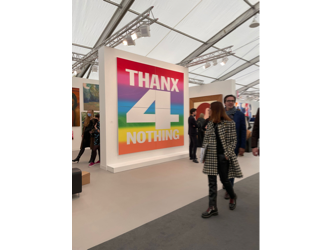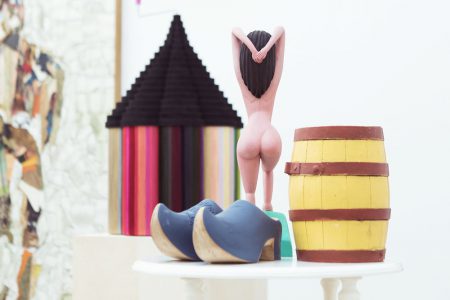A landmark of 20th-century architecture
The Maison de Verre is nothing less than one of the great landmarks of 20th-century architecture. Located in Saint Germain des Près in the courtyard of an 18th-century building, it cannot be seen from the outside.
Pierre Chareau

Pierre Chareau © François Halard
Architects from all over the world make the pilgrimage to visit this extremely modernist construction, built over four years and completed in 1932 by a man who wasn’t even a qualified architect: Pierre Chareau (1883-1950).
Jean and Annie Dalsace
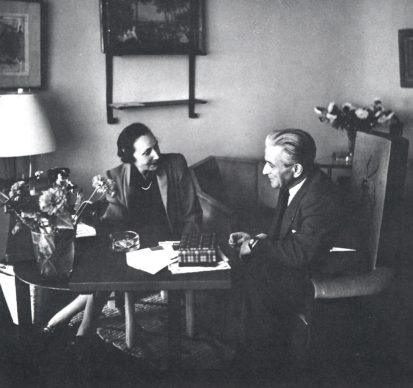
His first clients, from 1919 onwards, were the doctor Jean Dalsace and his wife Annie, who asked him in 1928 to undertake the task of transforming a dark town house into an avant-garde light-filled home. Its purpose was to accommodate the family on the first and second floors and to house the gynaecologist’s office on the ground floor.
Fighting like a lion
In 1932 Pierre Chareau wrote to Annie Dalsace: “Tell me I have fought like a lion for your house. I’m saving the first beats of my heart for your house” (1).
Glass bricks
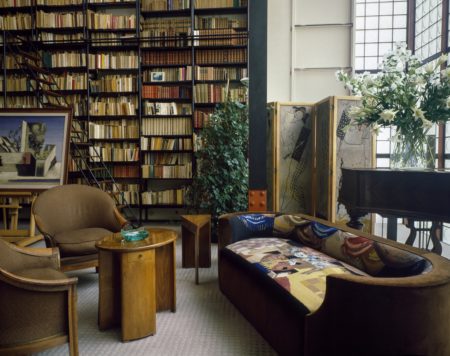
Pierre Chareau ©Evelyn Hofer
The façade of the building used glass bricks for the first time outside the industrial sector and which, when night falls, also allow electric light to enter from lamps placed on the outside.
Functional and pared back
A metallic structure, translucent walls, and wooden and iron furniture made by the ironwork master Louis Dalbet: everything was carefully calculated, to a degree pushed by Pierre Chareau, to be functional while also being extremely pared back.
Norman Foster
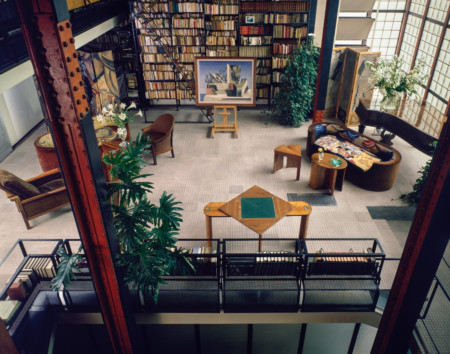
Maison de verre ©Evelyn Hofer
In the bedrooms, the cupboards can be accessed both from inside and outside the room so that the maids could tidy up while the inhabitants were still in bed. The famous British contemporary architect Norman Foster observes: “Chareau was fascinated by movement in all its forms. In the Maison de Verre the windows pivot, the stairs retract, and other mechanisms turn, slide and tilt.” (1)
Monument historique
In 1982 the house was classified as a “Monument historique”(historical monument) along with the majority of the furniture which was made for it.In 2005 it came into the possession of an architecture historian and American curator, Robert Rubin (see here Robert Rubin’s latest interview about his book on the cowboys of Richard Prince).
Yves Saint Laurent
At the time that it was put up for sale, the “official” interior designer of Yves Saint Laurent, Jacques Grange, reveals that he made the couturier pay a visit, who was incidentally with his partner Pierre Bergé a famous collector of art deco furniture (See here and here other interviews of Jacques Grange). “After the visit he told me he didn’t know how he could have lived there.” Saint Laurent clearly appreciated darker atmospheres.
Opium and David Lynch
However in 1988 an advertisement for the perfume Opium by Yves Saint Laurent was filmed inside the Maison by the filmmaker David Lynch. We recognize the majestic steps, the large wall of glass bricks and certain pieces of furniture from the house.
116 lots
On 7 October 2021 Christie’s is presenting a sale in Paris featuring an ensemble of 116 lots estimated at 3.7 million euros under the title “Annie and Jean Dalsace: the collections of La Maison de Verre”. It is comprised mainly of furnishings by Pierre Chareau plus some paintings and drawings, all of which belonged to the Dalsace family in some cases even before they entered the famous house.
Not only from la Maison de verre
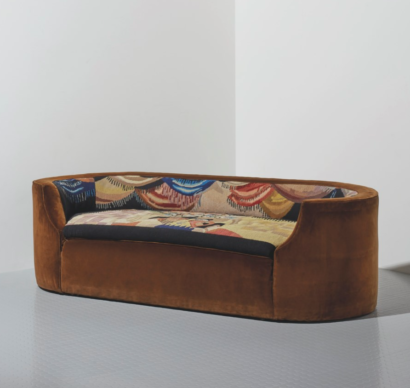
Pierre Chareau
It should be highlighted that the site, listed as a historical monument, is in no way stripped of its furnishings for the occasion. Incidentally, the descendants of the Dalsace family are making a “dation” to the state which is now underway.
Only 3 objects made for la Maison de verre

Pierre Chareau
As Cécile Verdier, president of Christie’s France and a design specialist, explains: “only three objects from the sale were made specially for the Maison de Verre”. (See here and here other interviews of Cécile Verdier).The others may have passed through…
Dalsace provenance
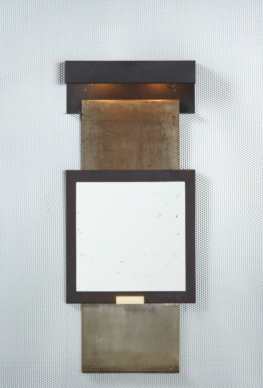
Pierre Chareau
The mythical aura remains and the prestigious “Dalsace” provenance will have played its part in the valuation of the ensemble.
Stable market
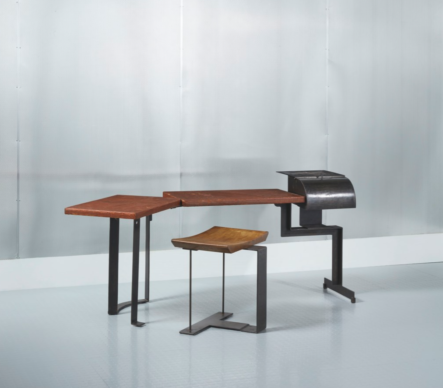
Pierre Chareau
The dealer and specialist on Chareau, Rafael Ortiz, who co-directed the Parisian gallery L’Arc en Seine until it closed in April 2021 observes: “Pierre Chareau’s furniture is particularly rare and the estimates in the sale do not take provenance into account. This is a strong and stable market.”
Cécile Verdier estimates that “this sale constitutes a fresh start for Pierre Chareau’s standing in the market.”
Jacques Grange points out that “this is the last major ensemble in private hands. He was a creator who was very ahead of his time. In art deco he is far more modern than other big names like Jacques-Emile Ruhlmann, for example.”
1,8 million
The record price obtained for Chareau at auction was for a majestic lamp standing 1.8 metres high, with a conical foot made of metal topped with sheets of alabaster, auctioned for 1.8 million euros in 2018. Nothing comparable is presented in this sale but there are a number of other objects which reflect his universe.
Furniture-sculptures
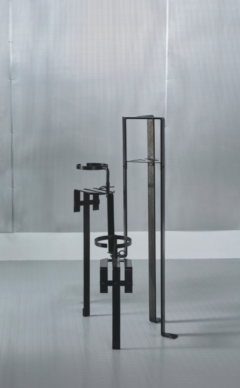
Pierre Chareau
“With him we can talk about furniture-sculptures,” says Rafael Ortiz, who alludes to several of his pieces which are “mechanized”. This the case of the “bureau dactylo”, a desk made as a single piece using planks of birch wood sheathed in leather, placed on strips of wrought iron with a matching stool. The different parts of the desk are mobile (estimate: 200,000 euros).
Planters
In the series of objects which on the face of it seem trivial but in fact constitute the pinnacle of the Chareau aesthetic, the catalogue also presents planters made from black wrought iron which resemble articulated abstract sculptures (estimate: 20,000 euros each). It would seem that Pierre Chareau designed a metal coat rack on wheels especially for the Maison de Verre, a copy of which is also at the Centre Pompidou (estimate: 40,000 euros).
Jean Lurçat
In the commercial made by David Lynch, the model sits on an oval couch covered in upholstery. It was designed by one of the architect’s close friends, Jean Lurçat. Made by Chareau in around 1923, the couch is presented by Christie’s with an estimate of 70,000 euros.
Robert Motherwell’s house

Pierre Chareau
In 1940 Pierre Chareau, who was Jewish, was forced into exile in the United States where he died in 1950. Three years before his death, he made an ingenious house for the abstract painter who would go on to become famous, Robert Motherwell, constructed using American army surplus materials. As horrible as it seems, it was destroyed. This is also how the Maison de Verre has become the emblematic creation of this architect and designer.
(1) Citations taken from the Christie’s sale catalogue.
7 October. www.christies.com
Donating=Supporting

Support independent news on art.
Your contribution : Make a monthly commitment to support JB Reports or a one off contribution as and when you feel like it. Choose the option that suits you best.
Need to cancel a recurring donation? Please go here.
The donation is considered to be a subscription for a fee set by the donor and for a duration also set by the donor.

